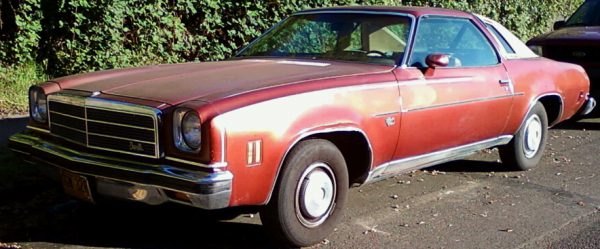
Car guy/gal or not, everyone remembers their first car. And mine had quite a mouthful for a name: Chevrolet Chevelle Malibu Classic Landau Colonnade Coupe. Today, I want to take you on a journey back to the beginning, the story of my first car, and the bittersweet end to our time together.
A New Beginning
My father bought this car brand new in April of 1974. He had always driven the “second car” in our family, with a short commute to the rail station. For years, he settled for cheap beaters, but in 1974, with a little more money in his pocket, he decided it was time to buy something new.
The price he paid was $4000, slightly above the sticker price of around $3900. It seemed the car had been sitting on the dealer lot for a while, as it had a unique combination of colors and a low option set. Sporting a Medium Metallic Green exterior, a black Landau top, and a green interior, it wasn’t everyone’s cup of tea. The Malibu Classic trim line was the highest available for 1974, but this model came with minimal options. It had a 350/2bbl V-8 engine, an automatic transmission (THM350), power steering, power brakes, and air conditioning. However, there were no power windows or locks, just vinyl bench seating, and an AM radio.
My Freedom on Four Wheels
During my early years, my father only drove the car for four miles a day, five days a week. On weekends, it usually sat idle in the garage as my mother used the “family car.” But when I got my learner’s permit in 1980, the car became mine to drive on nights and weekends. And drive it I did. Like everyone’s first car, it represented freedom to me. I regarded it as the greatest car ever sold, not because it was outstanding, but because it symbolized freedom.
By the fall of 1982, I was off to college, and the car became even more essential to me. My father had obtained a company car, so the Malibu was mine to use, albeit unofficially. He kindly kept the registration and insurance in his name, although I paid for it, to keep the insurance costs low. In 1986, I moved out of state, and it made sense for the car to be officially transferred to my name.
An Honest Review
The A-Body Colonnades, which the 1974 Chevrolet Malibu Classic belonged to, have been widely discussed on various websites. To avoid redundancy, I will only share a few personal impressions.
The car was overweight and underpowered. The 2-barrel 350 engine produced a mere 145hp and 250 lb./ft. of torque. Paired with a “highway economy” 2.73:1 rear axle ratio, it wasn’t the fastest car on the road. The fuel economy, while not terrible for that era, didn’t impress either. I could manage around 13-14 mpg in the city and up to 17 mpg on the highway if I drove carefully. The combination of a smog-choked engine and its hefty 3900+ pound curb weight didn’t help matters.
The weight issue also affected the front-end parts. The 73-77 Chevelles gained approximately 500 lbs. compared to their predecessors, but GM failed to upgrade the suspension and steering components accordingly. As a result, my car constantly required replacements for ball joints, tie rods, shock absorbers, and other front-end components.
However, the drivetrain was remarkably reliable. With only 0.41 horsepower per cubic inch, the engine components were never significantly stressed. When I sold the car, it had only accumulated 103,000 miles, and the only work ever done on the engine was replacing the valve-cover gaskets. The buyer, in fact, purchased the car to salvage the drivetrain for another project.
The End of an Era
Unfortunately, all good things must come to an end. In 1990, the Malibu was still fulfilling its duties, although by that time, I had acquired a second car, the Omni. One day, as I approached the Malibu, I noticed something hanging down underneath the rocker panel. Upon further inspection, a chunk of body, a body mount, and a piece of the frame fell into my hand. It was the end—an unfortunate ending for a car I once hoped to keep forever.
FAQs
Q: How much did the 1974 Chevrolet Malibu Classic cost?
A: The sticker price for the car was approximately $3900, but my father paid $4000 out the door.
Q: What features did the Malibu Classic have?
A: The Malibu Classic came with a V-8 engine (350/2bbl), an automatic transmission (THM350), power steering, power brakes, and air conditioning. However, it had no power windows or locks, vinyl bench seating, and an AM radio.
Q: How was the fuel economy of the Malibu Classic?
A: The car achieved around 13-14 mpg in the city and up to 17 mpg on the highway, which was considered decent for its time.
Conclusion
As the COAL series comes to an end, I would like to express my gratitude to Paul for allowing me to share my experiences with you. It’s been a pleasure to sharpen my writing and storytelling skills through this series.
I also want to extend my thanks to you, the readers, especially those who took the time to comment and provide feedback on my work. Your feedback is invaluable, and I appreciate it greatly.
Looking back, I never set out to establish a theme for this series. However, as one commenter pointed out, a common thread weaves through the stories—the experiences we gain from our cars, both good and bad, are what truly give them meaning.
Once again, thank you all.